The 2025 EPCOT International Flower & Garden Festival is in full swing and there are numerous garden destinations for guests to experience throughout the park.
Garden Destinations
There are new and returning garden destinations located throughout each of the four EPCOT neighborhoods of EPCOT. Guests can check the festival passport for a full list of the garden destinations and their locations.
Festival Blooms
Location: World Celebration

The first garden is more of a mural-style display, as flowers have been placed in specific patterns to make larger pictures.

When viewed from a bridge on the opposite side of the water, the patterns can be identified as larger flowers and butterflies.
Connections Conservatory Garden
Location: World Celebration – Inside Connections Cafe

A small planter has returned inside Connections Cafe, near the entrance facing Spaceship Earth. While this garden has no specific label, some of the many plants include ferns and orchids.
Blossoms of Fragrance Presented by Scentsy
Location: World Celebration – Bridge to World Showcase

The Blossoms of Fragrance Garden is presented by Scentsy, so it focuses on flowers with a distinctive smell.


The garden is divided into displays where a large butterfly topiary is made out of plants and flowers next to a Scentsy-sponsored display sign. Each sign has a specific associated smell that is emitted from a vent near the bottom.


Guests visiting each section are encouraged to experience the naturally-inspired scents and think of what delightful memories they associate with each smell.
Inside Out 2 Emotion Garden (NEW!)
Location: World Celebration – Walkway between the Imagination Pavilion and World Showcase

New to the festival this year is the Inside Out 2 Emotion Garden where guests can “meet the plants that inspire your emotions!”

Each emotion is displayed on a sign within a corresponding planter that matches the color of their emotion. In the photo above, Anxiety is featured on an orange sign and the planter and plants are also orange.


Joy and Sadness can also be found in the garden along with all the other emotions from “Inside Out 2.”
Playalong Bay Presented by Smucker’s Uncrustables (NEW!)
Location: World Celebration – Walkway between the Imagination Pavilion and World Showcase

Playalong Bay is a new play area that includes a play structure for small children, gardens, and some seating areas for guests to relax. The name is a play on Stormalong Bay, the pool located at Disney’s Yacht and Beach Club Resorts, since the two nearby outdoor kitchens are called Yacht Grub and Beach Grub.


The plants surrounding the play structure all match the tropical theme. Many of the plants are usually found growing near beaches, such as tropical milkweed and Fakahatchee grass.

The play structures are made of brown wood with bright blue details. One structure has a series of wobbling platforms on ropes. Some nearby platforms for children to climb on top of are shaped like driftwood.

One of the other structures include an igloo-like dome with holes through it. The tall structure near the right side has hanging plastic panels with buttons and wheels for children to manipulate.
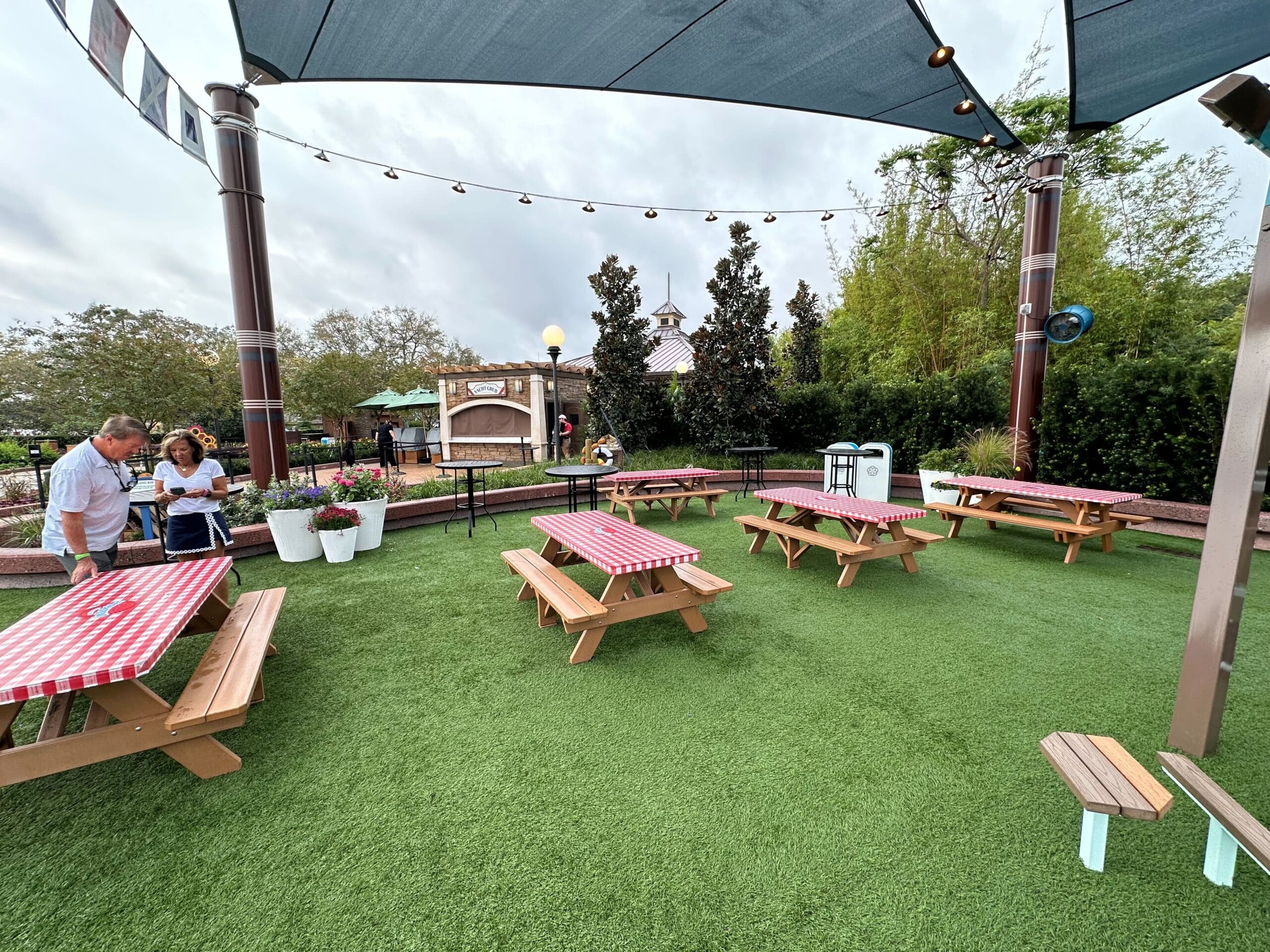
A group of picnic tables has been installed on the left side of the play structure. This is a great location to sit and eat after grabbing food at one of the nearby outdoor kitchens or watching children play. The whole area is also covered by a series of triangular tarps that help to block the bright Florida sun.
The Honey Bee-stro Garden Presented by National Honey Board
Location: World Celebration – Walkway between the Imagination Pavilion and World Showcase

The Honey Bee-stro Garden is located not far from the Honey Bee-stro outdoor kitchen. This garden focuses on displaying plants that act as food for honeybees.

In addition to flowers, the garden includes displays of boxes shaped like the beehives used by beekeepers, though they are only for display here and are not actually in use.

Cast Members in this garden were handing out yellow headbands shaped like Spike the Bee’s antennas.


Signs located throughout the garden explain the process of collecting honey from bees and how bees play a vital role in the global ecosystem.

Spike the Bee can be spotted flitting between some orange and yellow canna flowers.
Floating Gardens
Location: World Nature

The Floating Gardens are loosely described to be located in World Nature because they span most of the waterways in this section of EPCOT.

While many of them were floating in the water near the entrance to the Imagination! Pavilion, they can also be found in the water by the Odyssey Pavilion.

The Floating Gardens are small bundles of flowers placed in in a circle that are then allowed to float on the top of the water. Each circle is separated by color, and they are usually pink, orange, purple, or green.
Butterfly Landing Presented by AdventHealth
Location: World Nature

Butterfly Landing is a walkthrough exabit where guests inter a thin tent that houses several species of living butterflies. The entrance is located on the far right of the path leading towards the Imagination! Pavilion.

As guests get closer to the tent entrance, there is another butterfly topiary similar to the ones found in the Blossoms of Fragrance Garden.

A sign next to the entrance of the tent explains that most of the flowers inside are host plants or nectar plants. Host plants act as food for caterpillars, while nectar flowers feel fully-grown butterflies.

Guests are encourages to observe, but not touch, the butterfly residents. Butterfly Landing includes four main species of butterflies flying through the air: monarch, malachite, common buckeye, and zebra longwing.

Smaller signs placed between the flowers provide images of each butterfly species, making them easier for guests to identify.

Butterfly Landing is also home to many caterpillars that will become butterflies as the EPCOT International Flower & Garden Festival continues. As with the butterflies, guests are allowed to look at the caterpillars but not touch them.
Bold Bromeliads
Location: World Nature – Near The Land

The Bold Bromeliads is more of a display than an entire garden. Bromeliads are a flowering plant found growing in multiple locations, from rocky hillsides to rainforest trees.

The bromeliads are placed together in a tall tower structure that would make a great location for taking photographs. A few of the plants already have their signature spiky flowers in shades of maroon and purple.
English Tea Garden Presented by Twinings
Location: World Showcase – United Kingdom

Moving now to World Showcase, our first garden is the English Tea Garden located in the United Kingdom Pavilion. Plants in this area are commonly used to make distinctive tea flavors.

Signs near the path provide more insight into the tea-making process.

Displays of plants inside white teacups highlight plants used in Twinnings’ tea flavors. The nearby white signs include the full list of ingredients used in each blend, which often includes many more plants than their name would suggest.



As an example, the sign for Ultra Spice Chai is placed next to a display of cinnamon plants. A purple tag in the next teacup lists the flavor as Earl Grey Lavender Black Tea.
As a part of the 2025 EPCOT International Flower & Garden Festival, guests can sign up for a English Tea Garden Tour. Guests can sign up for a guided tour at The Tea Caddy shop. The guided tour takes approximately 30 minutes, and guests can only sign up for tours taking place on the same day.

Guests not wanting to complete a guided tour can still visit The Tea Caddy to pick up a Self-Guided Tea Tour brochure with more detailed explanations of the many plants found in the garden. More details can be found on the Tours page of the Festival Passport.
Shakespeare Garden
Location: World Showcase – United Kingdom

The Shakespeare Garden ties a little more history and literature into what appears like a standard garden. The plants displayed here were either used to help set the scene for one of Shakespeare’s performances or referenced as a symbol in one of his plays.


The white labels have the usual common and scientific names for identifying each plant. The pink labels, which are unique to this garden, are printed with quotes from one of Shakespeare’s plays or poems. Both of these quotes are from Shakespeare’s “Hamlet.”

Another “Hamlet” reference can be found on this large white sign, which explains how flowers all have meanings that were common in Shakespeare’s time. The sign shared the meaning behind some of the flowers mentioned during Ophelia’s famous flower speech.

Of course, no Shakespeare Garden would be complete without a stone bust of the man himself.
Topiary Heritage Garden
Location: World Showcase – United Kingdom

While topiaries have long been a staple of the EPCOT International Flower & Garden Festival, this garden in the United Kingdom Pavilion provides a little more context for the art of shaping plants into shapes.

The sign explains that this garden includes examples of three different types of topiary: free-from, standard, and shrub.

The topiary shaped like Mickey Mouse in the center of the garden is an example of the shrub variety.

A tree in the middle of the walking path has a sign further illustrating the history of topiaries at Walt Disney World and how “the legacy of topiary in Disney Parks began.”
Haute Nature (NEW!)
Location: World Showcase – France

The only completely new garden added to World Showcase this year is the Haute Nature Garden. Flowers here have been planted inside metal displays shaped like clothing mannequins. The plants grow out between the metal bars to form a ‘skirt’ for each ensemble.
Bouquet Garden
Location: World Showcase – France

The second France Pavilion garden is returning from previous festivals. As explained by the sign, the Bouquet Garden highlights flowers that are traditionally used for decorative arrangements.


Unlike many of the other gardens, flowers here are planted neatly in rows by type. This makes harvesting the flowers easier, since they might not all need to be harvested at the same time for optimal blooming.


The sign also explains the flowers being planted in rows helps to ensure they all receive equal amounts of sun, as taller plants might block sunlight from reaching shorter plants.

Each row of flowers has a label with both their common and scientific name for easy identification.
Spice Garden
Location: World Showcase – Morocco

The Morocco Pavilion Spice Garden features plants commonly ground into cooking spices. The sign in the garden informs guests that spices have historically been valued more than gold, and many communities today are still known for their signature spice blends.

A smaller label placed in the center of the garden provides more context for the exact plants used to represent Morocco. Some of the many ingredients mentioned include mint, saffron, cumin, ginger, sesame seed, and more.

Guests visiting this garden are encouraged to see how many plants they can locate out of a provided list of common spices.
Kokedama Garden
Location: World Showcase – Japan

The Kokedama Garden in Japan is made of a small section of bamboo tubes placed between rocks. The tall tubes in the center pump flowing water, which then spills out into the smaller tubes.

Many of the smaller tubes direct the water to miniature drums and chimes, which make noise as the water flows. The noises fill this area with peaceful sounds perfect for meditation.
Shishi-odoshi
Location: World Showcase – Japan

The second garden in the Japan Pavilion is not a garden in the traditional sense, as it focuses on traditional Japanese water fountains known as Shishi-odoshi or “scare deer.”

These unique fountains use a slow flow of running water into a bamboo tube to create a periodic tapping noise. The noise is intended to scare off any wild animals who may be tempted to enter a garden for an uninvited snack.

The Shishi-odoshi displayed in EPCOT is a bit more complicated than a single bamboo tube. Here, water flows through a series of tubes into a waterwheel. The force of the water running into the wheel causes it to turn, which powers two xylophone-style chimes on either side.
Bonsai Collection
Location: World Showcase – Japan

The final garden in the Japan Pavilion focuses entirely on the iconic art of bonsai.

The garden is arranged like a Japanese rock garden, with ripple-like lines drawn around several of the larger boulders. Individual small trees cultivated in the bonsai style are placed on wooden pedestals around the garden.


There are a total of five plants on display. Each plant has its own label with the name of the tree, age of the tree, and the style in which the tree has been grown.



The age for each tree has been divided between the total age of the plant and the number of years the plant has been a “Tree in Training.” The oldest tree is 60 years old and has been in training for 20 years.
Garden Italiano
Location: World Showcase – Italy

The Garden Italiano in the Italy Pavilion showcases plants commonly used in Italian food. Many of the plants here are displayed in terra cotta pots, as they would be a patio or balcony.
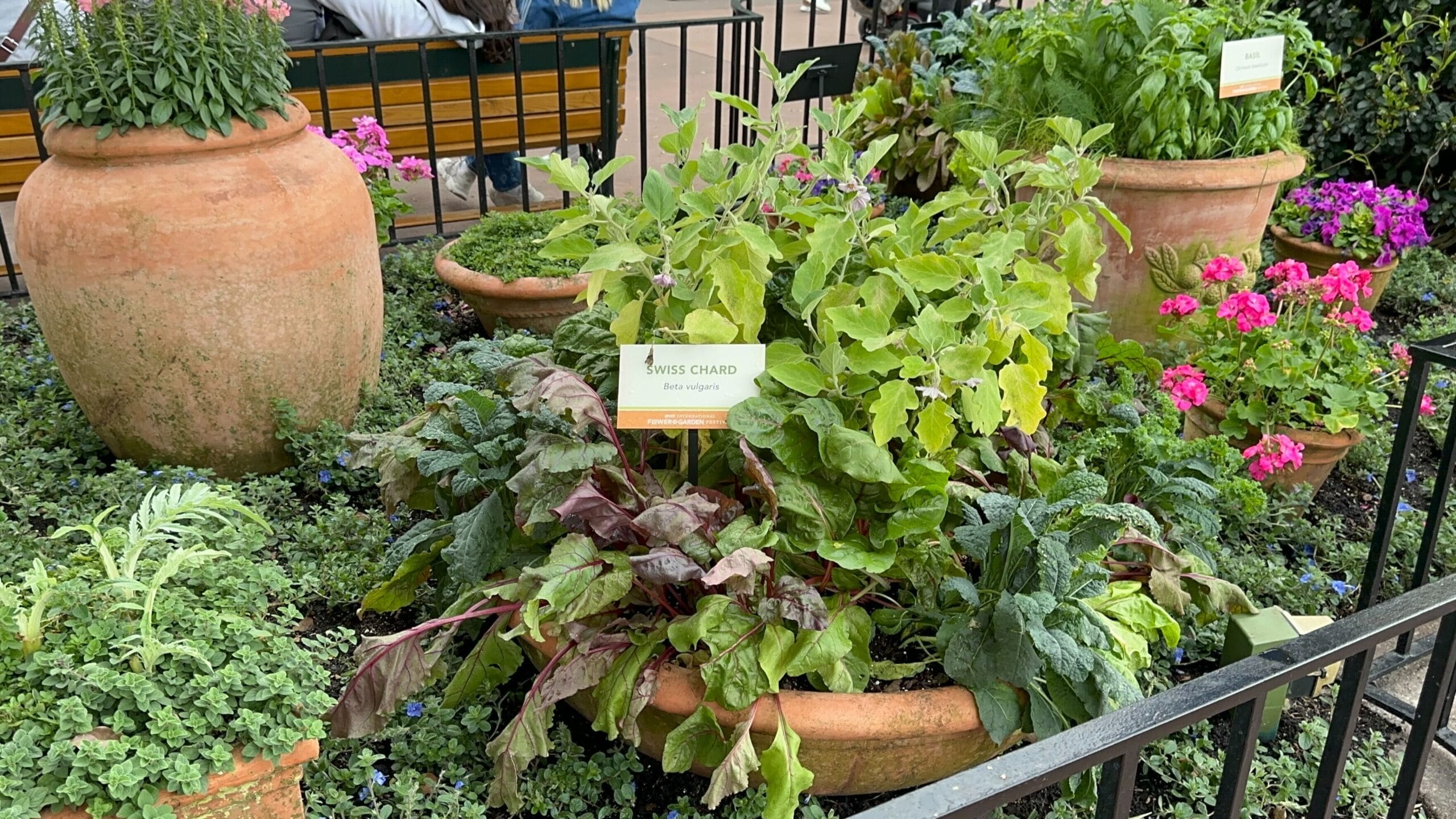


Some of the plants commonly used in an Italian kitchen include Swiss chard, cabbage, and thyme.


The final two displays with pink flowers have describing the terra cotta pots rather than the plants themselves. The labels explain a brief history of Sienna and Impruneta Terra Cotta, which are created using clay only found in specific provinces in Italy.
China Penjing Garden
Location: World Showcase – China

The Penjing Garden shows off several small treelike plants on individual red pedestals.



Each plant in the display has an individual label with its common and scientific names. Interestingly, the labels also include the age in years for each small tree and the name of each gardener presenting each plant for viewing.

When we photographed this garden, the largest sign describing the display was still missing. The wooden post has been put into place, so the sign will likely be installed soon.
Bamboo Garden
Location: World Showcase – China
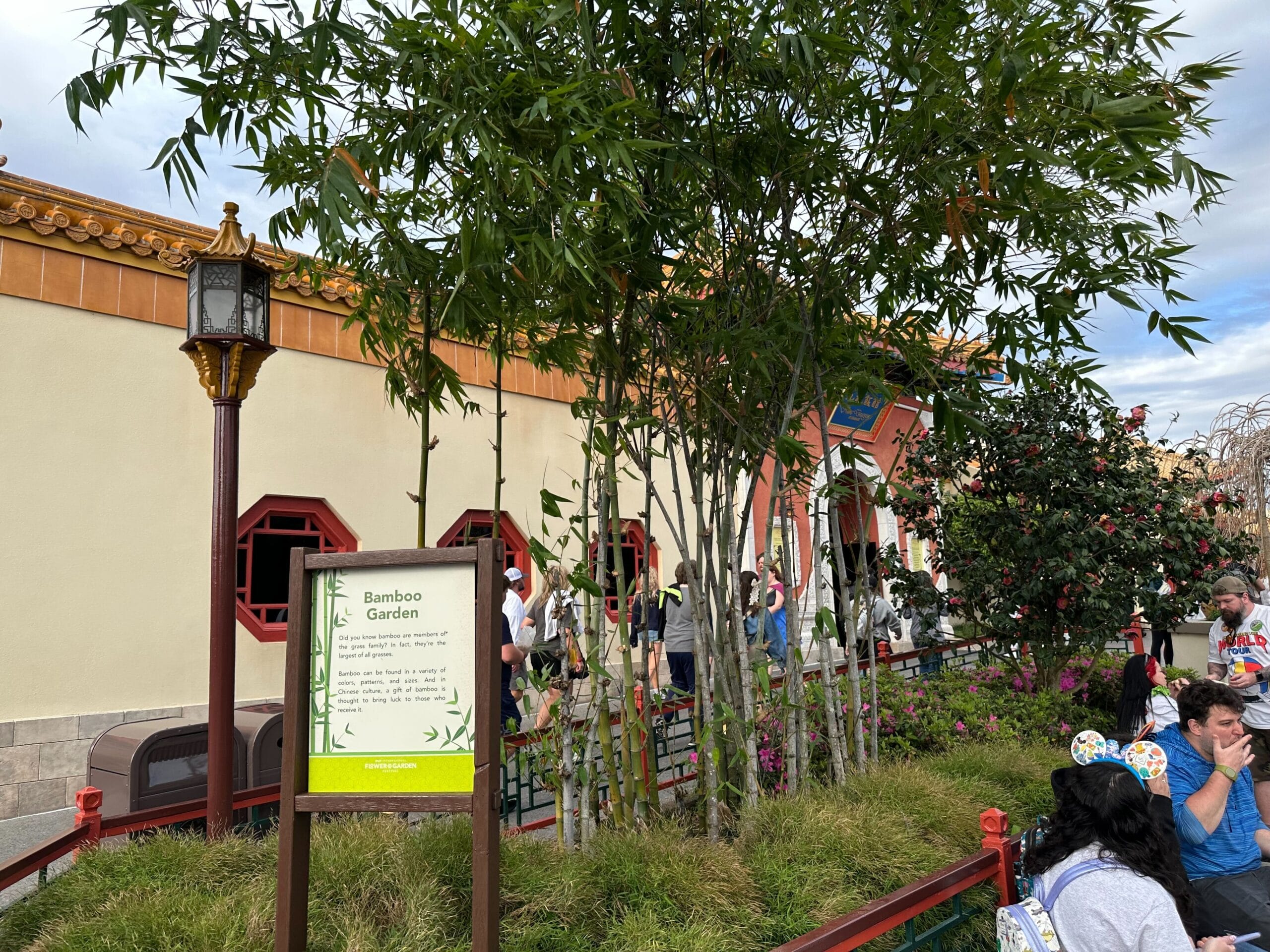
The second festival location in the China Pavilion is the Bamboo Garden. As one would expect from the name, this section in the middle of a walkway has been planted with several stalks of bamboo.

The sign for the garden informs guests that bamboo is actually part of the grass family. Bamboo also comes in many colors and sizes, not just the tall green plants one usually associates with bamboo.
Tropical Rainforest Garden
Location: World Showcase – Mexico

The first of multiple garden spaces near the Mexico Pavilion is the Tropical Rainforest. As the sign explains, this area has bee covered in plants that are usually found in the rainforests of Central and South America.

Since rainforest plants need to reach up higher for sunlight, many of them are growing up the trees or stand tall with their strong stems.
Extraordinary Orchids
Location: World Showcase – Mexico

The Extraordinary Orchids are located on the left side of the Mexico Pavilion main building, very close to the Tropical Rainforest. Since the rainforest sign mentions the orchids, this small garden does not get its own sign. The orchids have been planted up off the ground, in the branches of several nearby trees.


The orchids come in bright shades of purple, pink, light yellow, and white. Multiple colors have been planted together on each of the trees.
Desert Garden
Location: World Showcase – Mexico

One of the smaller garden locations in World Showcase is the Mexico Desert Garden. It is located outside the main Mexico Pavilion pyramid, in a section surrounded by metal railing.

As the nearby sign explains, the Desert Garden showcases several low-maintenance plants that have adapted to store water in arid regions, such as various forms of cacti.
Community Garden
Location: World Discovery – Near Joffrey’s Coffee & Tea Company

The Community Garden can easily be found on maps as the home of the Donald Duck topiary, though it actually includes more than one area. Donald is seen holding a hoe and a bag, looking up at a bee that has landed on his forehead.

The sign near Donald explains that a community garden is a place where people can come together to work on cultivating the land and sharing the benefits.

The plants in the Community Garden are comprised of flowers and herbs more often found in neighborhoods or home gardens, such as thyme, lettuce, and wallflowers. Each plant is grouped together in a section with a white label to help guests identify them.

While a little further away from Donald, this concrete planter with trees has also been decorated to match the Community Garden theme. A wooden stand with what appears to be more Swiss chard has been placed in the center.
Prehistoric Plants
Location: World Discovery – Near Mission: SPACE
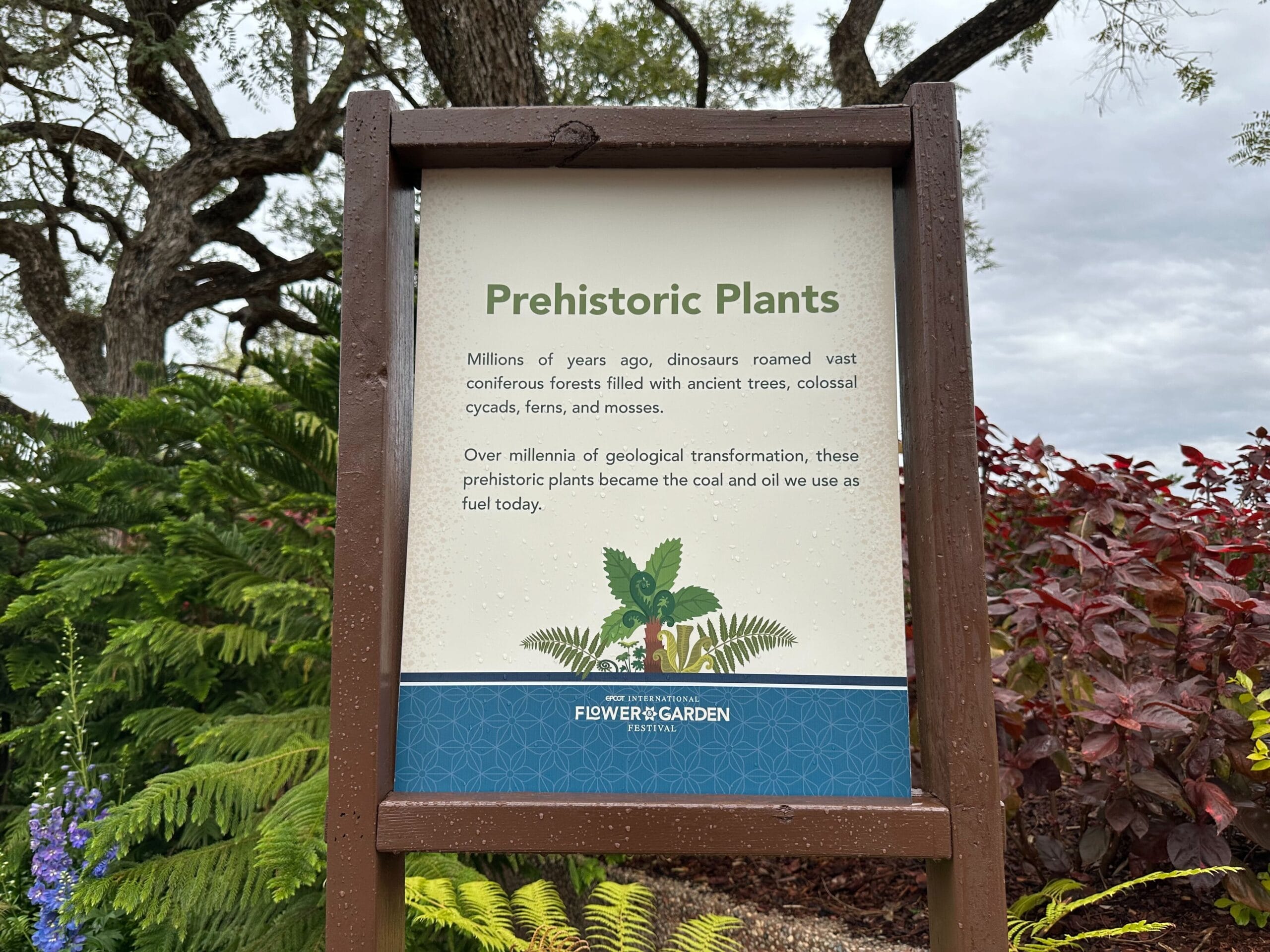
The prehistoric plants garden is filled with plants known for existing thousands of year ago, back when dinosaurs roamed the earth. The sign for the garden explains that many of the plants on display were slowly transformed into the coal and oil we use today.

The plants on display include leafy ferns, small wildflowers, and moss.

To help add to the prehistoric theme of the garden, several of the displays have become the home of tiny dinosaur figurines. The dinosaurs are placed throughout the garden, so guests can have fun trying to spot them all.
Camp Get Out ‘N’ Play Garden Presented by OFF!
Location: World Discovery – Between Creations Shop and Refreshment Station Hosted by Coca-Cola

The final location is the Camp Get Out ‘N’ Play Garden Presented by OFF! This garden is located to the left of the Creations Shop Entrance facing Test Track.
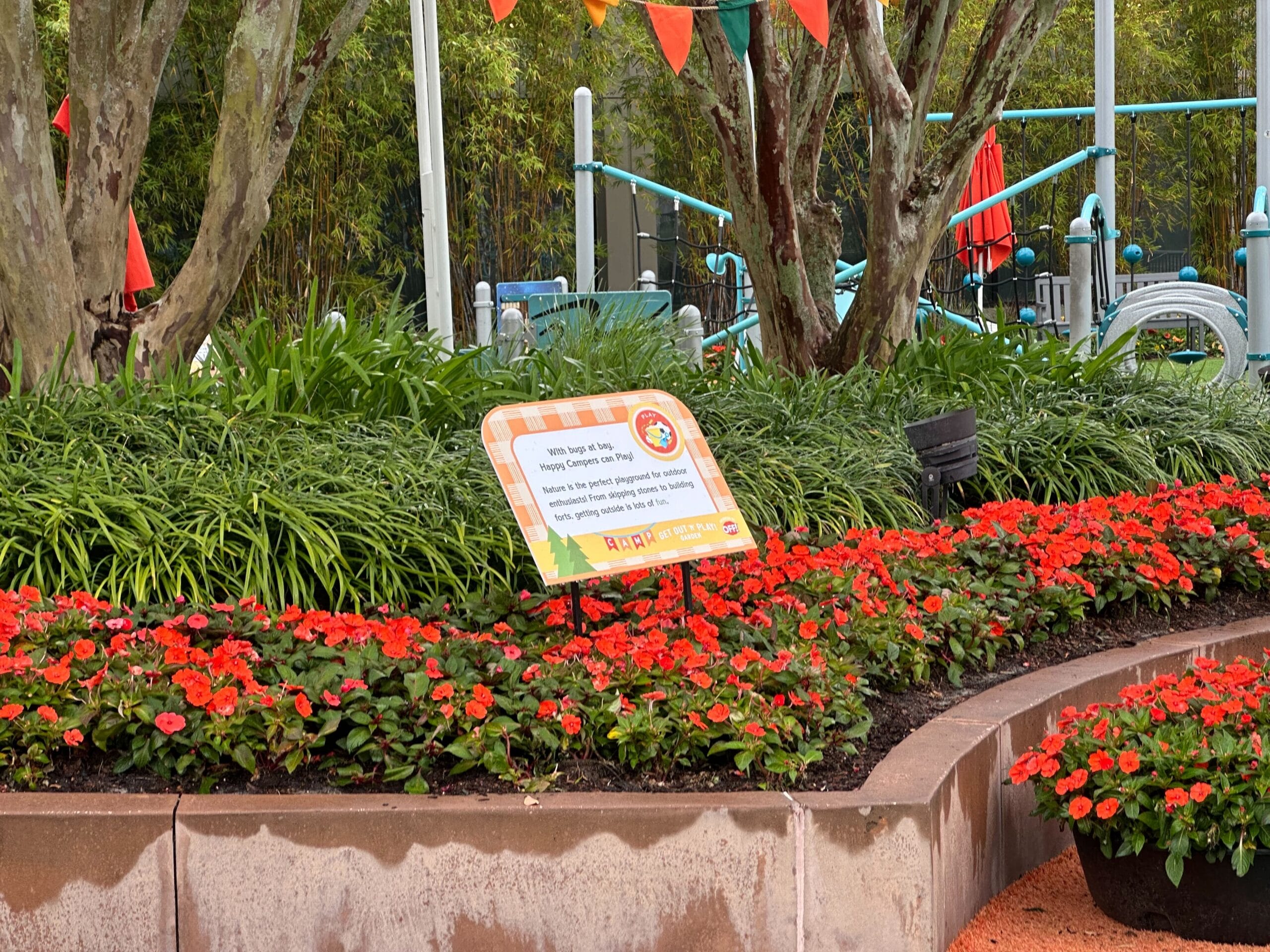
This garden is themed around plants that can be used as a natural deterrent for insects like mosquitoes. The sign in the flowerbed reads, “With bugs at bay, happy campers can play! Nature is the perfect playground for outdoor enthusiasts! From skipping stones to building forts, getting outside is lots of fun.”
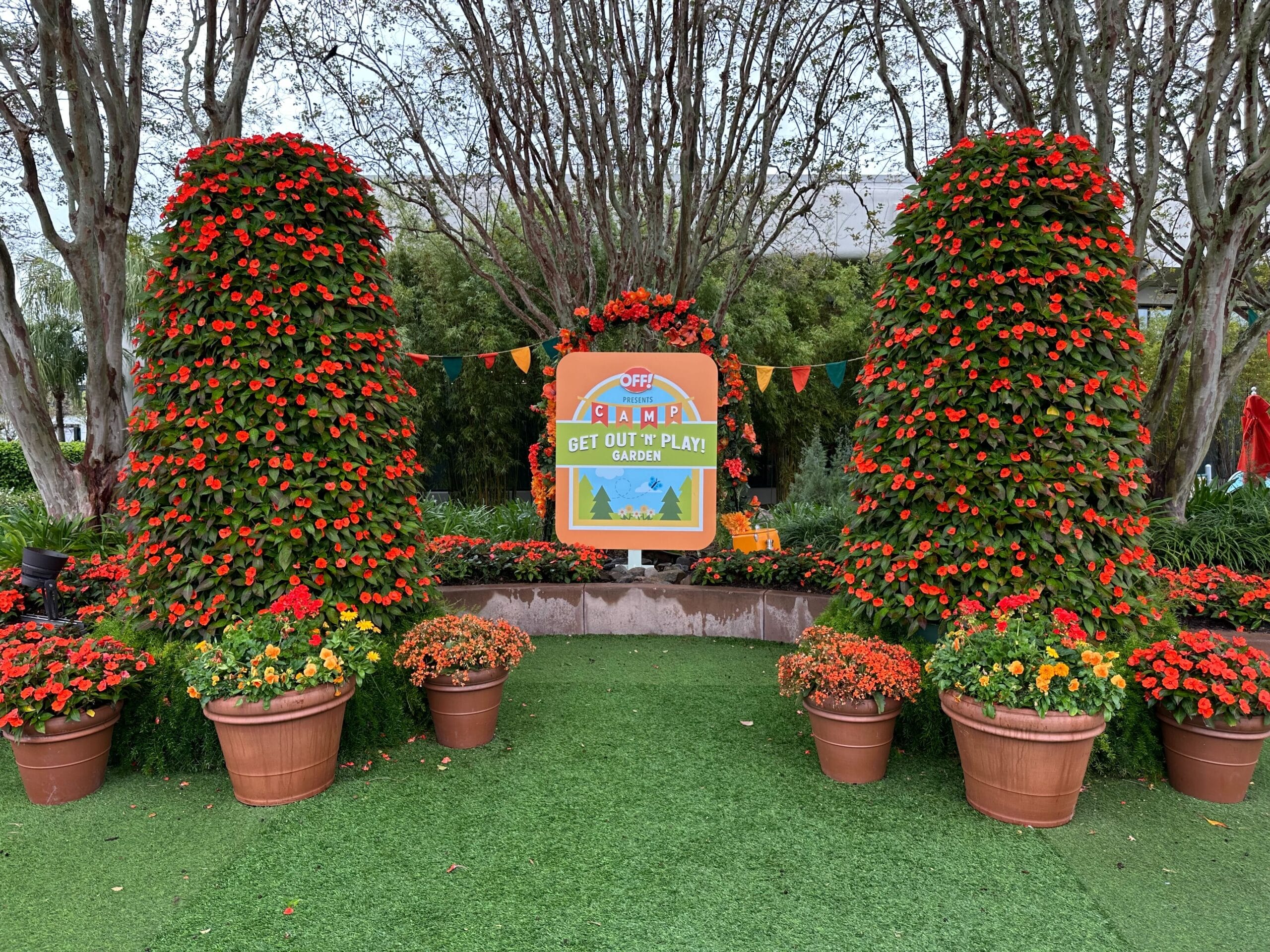
One of the main attractions for this location is a cute photo-op with two towers of orange flowers. Several small potted plants line the nearby walkway, and the sign in the center has the name and sponsor for the garden.
Which new or returning garden spot is your favorite? Let us know in the comments.
For the latest Disney Parks news and info, follow WDW News Today on Twitter, Facebook, and Instagram.


